Innovative Power Generation System for Large Ships Based on Fuel Cells: A Technical–Economic Comparison with a Traditional System
Abstract
1. Introduction
- Market barriers preventing their use;
- Uncertainty about which technical options are ready for commercialization.
2. State-of-the-Art FC—Topology
3. The Two Architectures Analyzed
- Reliability and operational safety;
- Contained weights and volumes of electrical machines;
- Limited mechanical vibrations;
- Reduced possibility of fire.
- Increased operational reliability and safety;
- Containment of the weights and volumes of electrical machines;
- Limits on mechanical vibration;
- Reduced possibility of fire;
- Reduced port pollution.
4. Case Study: Introduction and Scope
- Two for propulsion;
- Two for on-board services (hotel loads).
5. Comparison Between Traditional Generators and FC System
5.1. Weight and Volume Evaluation of Traditional Generator Tank
- Generator weight (12,594 kg) and fuel/h weight;
- Generator volume (24 m3).
5.2. Sizing of Power Generators for On-Board Services
5.3. Weight and Volume Comparison Between Old Generators and New FC System
6. Technical and Economic Comparison Between Old Generators and New FC Technology
6.1. Purchase Cost and Initial Investment
6.2. Maintenance and Operation Costs
- EUR 15,000 for annual maintenance of the engine and alternator;
- EUR 60,000 every 5 years;
- EUR 15,000 over 5 years in various expenses not included in previous expenses;
- Total for 5 years: EUR 150,000.
- 1% per year of total invested capital: EUR 15–30,000;
- 15% of annual capital invested for stack replacement: for this study, we consider the constant value of EUR 450,000.
6.3. Estimation and Prediction
6.4. Results Discussion
7. Reliability
- each component of the system is represented with a block;
- different system configurations are considered, essentially to compare the traditional system with the proposed one.
7.1. Reliability of Conventional Generator
- Control instrument failures;
- Breaker failures;
- Cooling system failures;
- Engine failures (here, there will be many possible failure events related to the large number of mechanical components);
- Exhaust system-related failures;
- Fuel-related failures (starting from the fuel tank and going to the filters, pumps, any valves and injectors);
- Failures related to the generator itself;
- Failures related to oil lubrication.
- CB is circuit breaker;
- SBB is switchgear busbar;
- GEN is generator;
- FRF is fire risk factor;
- INV is inverter;
- FC is fuel cell.
7.2. Reliability of FC System
7.3. Reliability Comparison
8. Conclusions
Author Contributions
Funding
Data Availability Statement
Conflicts of Interest
References
- Coroiu, M. Energy efficiency holistic approach for new energy business model towards 2030. In Proceedings of the 8th International Conference on Modern Power Systems (MPS), Cluj-Napoca, Romania, 21–23 May 2019. [Google Scholar] [CrossRef]
- Campisi, D.; Mancuso, P.; Mastrodonato, S.L.; Morea, D. Efficiency assessment of knowledge intensive business services industry in Italy: Data envelopment analysis (DEA) and financial ratio analysis. Meas. Bus. Excel. 2019, 23, 484–495. [Google Scholar] [CrossRef]
- European Commission. Regulation of the European Parliament and of the Council; European Commission: Brussel, Belgium, 2021; pp. 1–4.
- van Biert, L.; Godjevac, M.; Visser, K.; Aravind, P.V. A review of fuel cell systems for maritime applications. J. Power Sources 2016, 327, 345–364. [Google Scholar] [CrossRef]
- Project “MARANDA”. Available online: https://projectsites.vtt.fi/sites/maranda/index.html (accessed on 15 January 2025).
- Project “SHIPFC” on the Use of Ammonia as a Fuel in SOFC. Available online: https://cordis.europa.eu/project/id/875156 (accessed on 25 January 2025).
- Project “NAUTILUS” on the Use of LNG in SOFC Hybridized with Batteries. Available online: https://nautilus-project.eu/ (accessed on 25 January 2025).
- Project “eShyps” the Wave of Hydrogen. Available online: https://e-shyips.com (accessed on 25 January 2025).
- GIIGNL. “Basic Properties of LNG,” The International Group of Liquefied Natural Gas Importers. 2019. Available online: https://giignl.org/wp-content/uploads/2021/10/giignl2019_infopapers1.pdf (accessed on 10 January 2025).
- Chaudhary, S.; Chauhan, Y.K. Studies and performance investigations on fuel cells. In Proceedings of the International Conference on Advances in Engineering & Technology Research (ICAETR-2014), Unnao, India, 1–2 August 2014; pp. 1–6. [Google Scholar] [CrossRef]
- Guaitolini, S.; Yahyaoui, I.; Fardin, J.F.; Encarnacao, L.F.; Tadeo, F. A review of fuel cell and energy cogeneration technologies. In Proceedings of the 9th International Renewable Energy Congress (IREC), Hammamet, Tunisia, 20–22 March 2018; pp. 1–6. [Google Scholar] [CrossRef]
- Smith, J.; Nehrir, M.; Gerez, V.; Shaw, S. A Broad Look at the Workings, Types and Applications of Fuel Cells. In Proceedings of the IEEE Conference, Chicago, IL, USA, 21–25 July 2002; pp. 70–75. [Google Scholar] [CrossRef]
- EMSA. Study of the Use of Fuel Cells in Shipping; EMSA: Lisbon, Portugal, 2017. [Google Scholar]
- Sulligoi, G.; Vicenzutti, A.; Tironi, E.; Corti, M.; Lamedica, R.; Ruvio, A.; Lipardi, G.; Piva, L. Naval smart grid: Integrated Power System for all electric naval vessels with control and reliability characteristics. In Proceedings of the 2014 AEIT Annual Conference—From Research to Industry: The Need for a More Effective Technology Transfer (AEIT), Trieste, Italy, 18–19 September 2014; pp. 1–6. [Google Scholar] [CrossRef]
- Bozorgmehri, S.; Hamedi, M. Modeling and optimization of anode-supported solid oxide fuel cells on cell parameters via artificial neural network and genetic algorithm. Fuel Cells 2012, 12, 11–23. [Google Scholar] [CrossRef]
- Aslinezhead, M.; Doremami, E.; Olamaei, J. Micro-combined heating and power generation and an economical and technical comparison of fuel cell technologies used. In Proceedings of the 17th Conference on Electrical Power Distribution (EPDC), Tehran, Iran, 2–3 May 2012; pp. 1–6, ISBN 978-1-4673-1418-3. [Google Scholar]
- Sarioglu, L.; Klein, O.P.; Schroder, H.; Kucukay, F. Energy Management for Fuel-Cell Hybrid Vehicles Based on Specific Fuel Consumption Due to Load Shifting. IEEE Trans. Intell. Transp. Systems. 2012, 13, 1772–17871. [Google Scholar] [CrossRef]
- D’Agostino, F.; Gualeni, P.; Schiapparelli, G.; Silvestro, F. Control Strateegy and Architecture for Integrating Distributed Fuel Cells on board Large Cruise Ships. In Proceedings of the 2020 International Symposium on Power Electronics, Electrical Drives, Automation and Motion (SPEEDAM), Sorrento, Italy, 24–26 June 2020; pp. 414–418. [Google Scholar] [CrossRef]
- Wu, Y.; Breaz, E.; Gao, F.; Paire, D.; Miraoui, A. Nonlinear Performance Degradation Prediction of Proton Exchange Membrane Fuel Cells Using Relevance Vector Machine. IEEE Trans. Energy Convers. 2016, 31, 1570–1582. [Google Scholar] [CrossRef]
- Haseltalab, A.; Van Biert, L.; Sapra, H.; Mestemaker, B.; Negeborn, R. Component sizing and energy management for SOFC-based ship power system. Energy Convers. Manag. 2021, 245, 114625. [Google Scholar] [CrossRef]
- Wu, Z.; Zhu, P.; Yao, J.; Xu, H.; Chen, B.; Yang, F.; Zhang, Z.; Porpatham, E.; Ni, M. Dynamic modeling and operation strategy of natural gas fueled SOFC-Engine hybrid power system with hydrogen addition by metal hydride. eTrasportation 2020, 5, 100074. [Google Scholar] [CrossRef]
- Skjong, E.; Rødskar, E.; Cabrera, M.M.M.; Johansen, T.A.; Cunningham, J. The marine vessel’s electrical power system: From its birth to present day. Proc. IEEE 2015, 103, 2410–2424. [Google Scholar] [CrossRef]
- D’Agostino, F.; Fidigatti, A.; Ragaini, E.; Silvestro, F. Integration of Shipboard Microgrids Within Land Distribution Networks: Employing a Ship Microgrid to Meet Critical Needs. IEEE Electrif. Mag. 2019, 7, 69–80. [Google Scholar] [CrossRef]
- Dumitrescu, M. Electric -power Supply Fault Tolerant Analysis for a Naval System. In Proceedings of the International Symposium on Electrical and Electronics Engineering (ISEEE), Galati, Romania, 28–30 October 2021; pp. 1–4. [Google Scholar] [CrossRef]
- IEC/ISO/IEEE 80005-1:2012; Artist, Utility Connections in Port-Part 1: High Voltage Shore Connection (HVSC) Systems—General Requirements; [rt]. (2006/339/EC) Edition 1.0 2012-07. 2012. Available online: https://standards.ieee.org/ieee/80005-1/5461/ (accessed on 9 December 2024).
- IEEE Recommended Pratice for 1kV to 35kV Medium-Voltage DC Power System on Ships. in IEEE std 1709-2018 (revision of IEEE std 1709-2010), December 2018, pp. 1–54. Available online: https://img.antpedia.com/standard/files/pdfs_ora/20230616-ieee/IEEE/Std/IEEE%20Std%201709-2018.pdf (accessed on 15 December 2024).
- Caprara, G.; Armas, V.; Mesquita, D.; Kermani, M.; Martirano, L. An Energy Storage System to support Cruise Ships Cold Ironing in the Port of Civitavecchia. In Proceedings of the 2021 IEEE International Conference on Environment and Electrical Engineering and 2021 IEEE Industrial and Commercial Power Systems Europe (EEEIC/I&CPS Europe), Bari, Italy, 7–10 September 2021; pp. 1–5. [Google Scholar] [CrossRef]
- Challamel, R.; Calmettes, T.; Gigot, N.C. A European hybrid high performance Satellite-AIS system. In Proceedings of the 2012 6th Advanced Satellite Multimedia Systems Conference (ASMS) and 12th Signal Processing for Space Communications Workshop (SPSC), Vigo, Spain, 5–7 September 2012; pp. 246–252. [Google Scholar] [CrossRef]
- Zeng, J.; Wang, M.; Liu, Y.; Qian, Y. Characteristics and prevention of road transport liquefied natural gas (LNG) accidents. In Proceedings of the 7th Advanced Forum on Transportation of China (AFTC 2011), Beijing, China, 22–22 October 2011; pp. 221–225. [Google Scholar] [CrossRef]
- Barelli, L.; Baumann, M.; Bidini, G.; Ottaviano, R.; Schneider, S.; Passerini, L. Trombetti. Reactive Metals as Energy Storage and Carrier Media: Use of Aluminum for Power Generation in Fuel Cell-Based Power Plants. Energy Technol. 2020, 8, 2000233. [Google Scholar] [CrossRef]
- Elia, S.; Santantonio, A. Fire Risk in MTBF Evaluation for UPS System. Adv. Electr. Electron. Eng. 2016, 14, 189–195. [Google Scholar] [CrossRef]
- Elia, S.; Santini, E.; Tobia, M. Comparison between Different Electrical Configurations of Emergency Diesel Generators for Redundancy and Reliability Improving. Period. Electr. Eng. Comput. Sci. 2018, 62, 144–148. [Google Scholar] [CrossRef]
- Boccaletti, C.; Elia, S.; Salas, M.; Pasquali, M. High reliability storage systems for genset cranking. J. Energy Storage 2020, 29, 101336. [Google Scholar] [CrossRef]
- D’Orazio, A.; Elia, S.; Santini, S.; Tobia, M. Succor System and Failure Indication for the Starter Batteries of Emergency Gensets. Period. Electr. Eng. Comput. Sci. 2020, 64, 412–421. [Google Scholar] [CrossRef]
- Rahmat, M.K.; Jovanovic, S.; Lo, L.K. Uninterruptible Power Supply (UPS) system configurations: Reliability comparison. In Proceedings of the 2010 IEEE International Conference on Power and Energy, Kuala Lumpur, Malaysia, 29 November–1 December2010; pp. 835–840. [Google Scholar] [CrossRef]
- Fairfax, S.; Dowling, N.; Weidknecht, P. Reliability Assessment of a Large Diesel Generator Fleet. IEEE Trans. Ind. Appl. 2020, 56, 942–951. [Google Scholar] [CrossRef]
- 493-2007—IEEE Recommended Practice for the Design of Reliable Industrial and Commercial Power Systems; IEEE: Piscataway, NJ, USA, 2007; ISBN 978-0-7381-5301-8. [CrossRef]
- Parliament, E.; Soone, J. Fuel EU Maritime—Sustainable Maritime Fuels; European Parliament: Strasbourg, France, 2022.

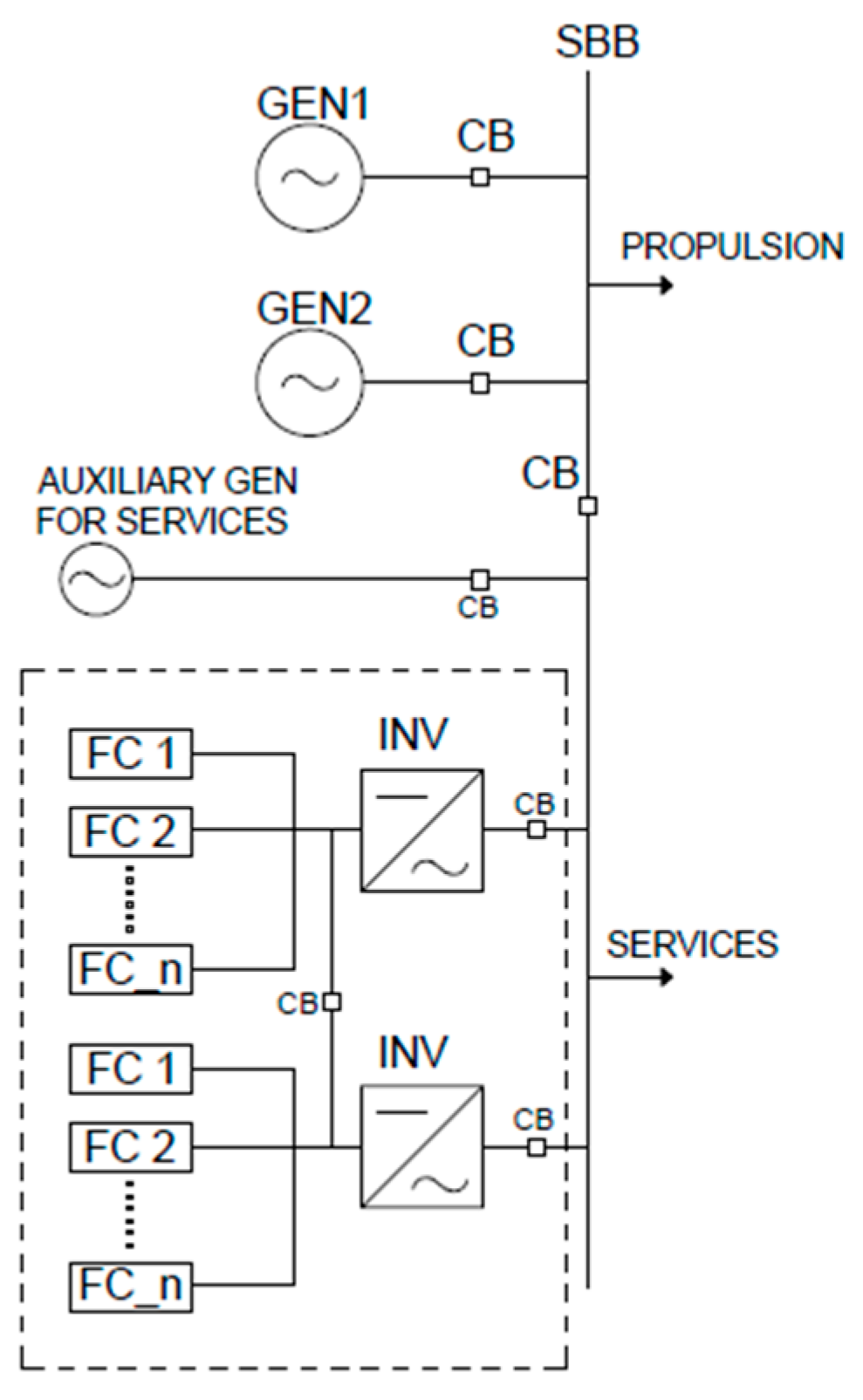
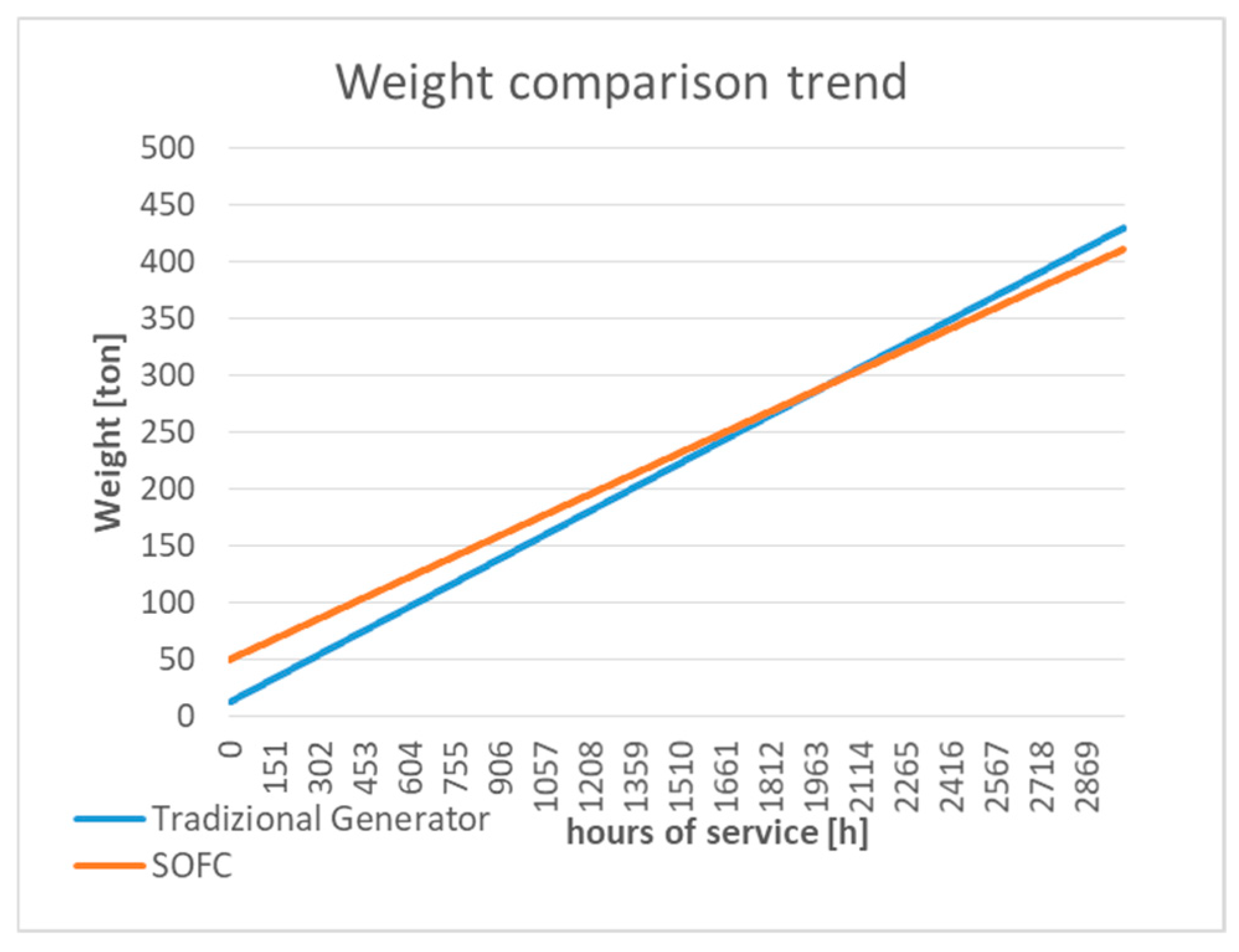
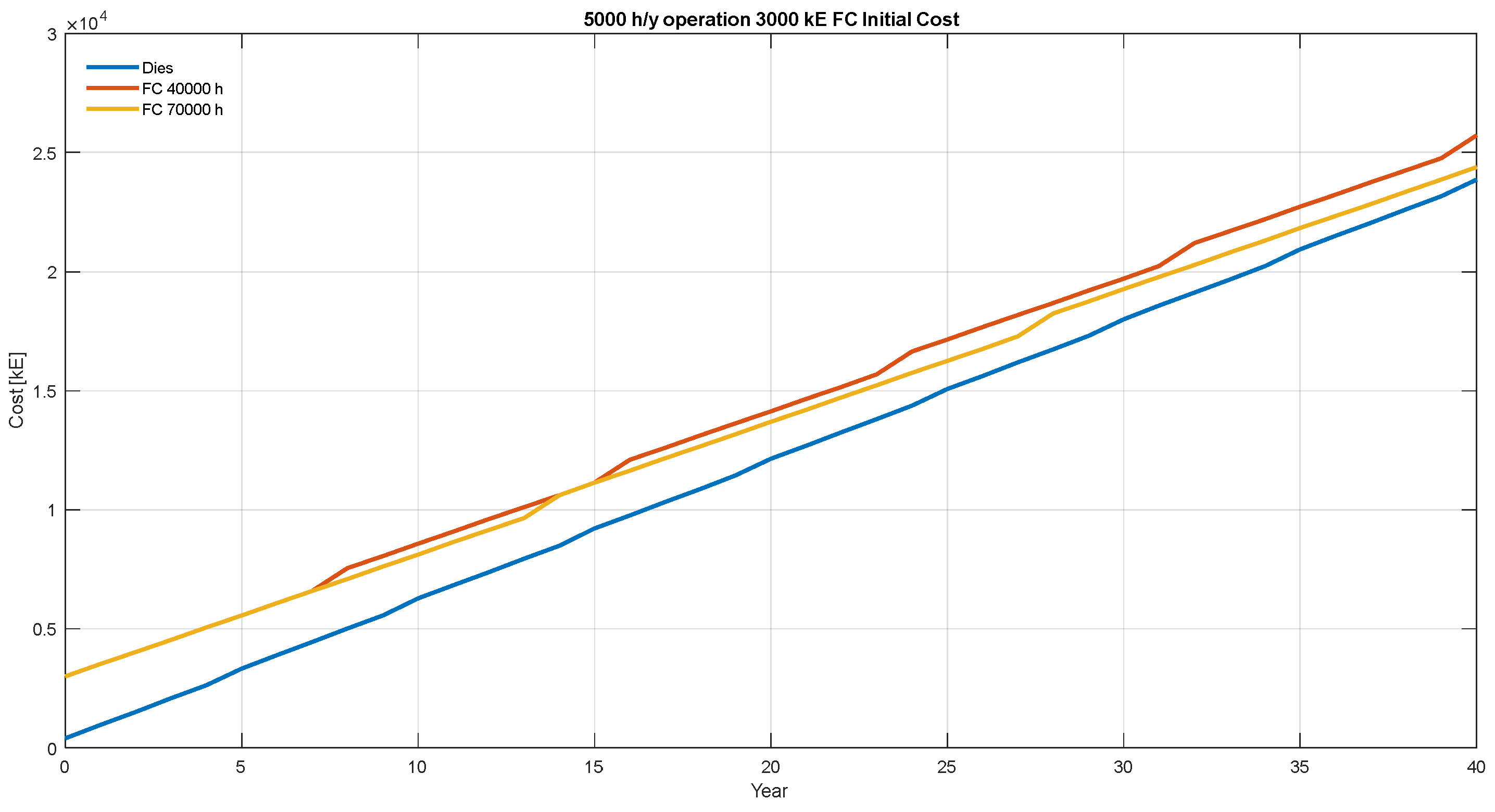
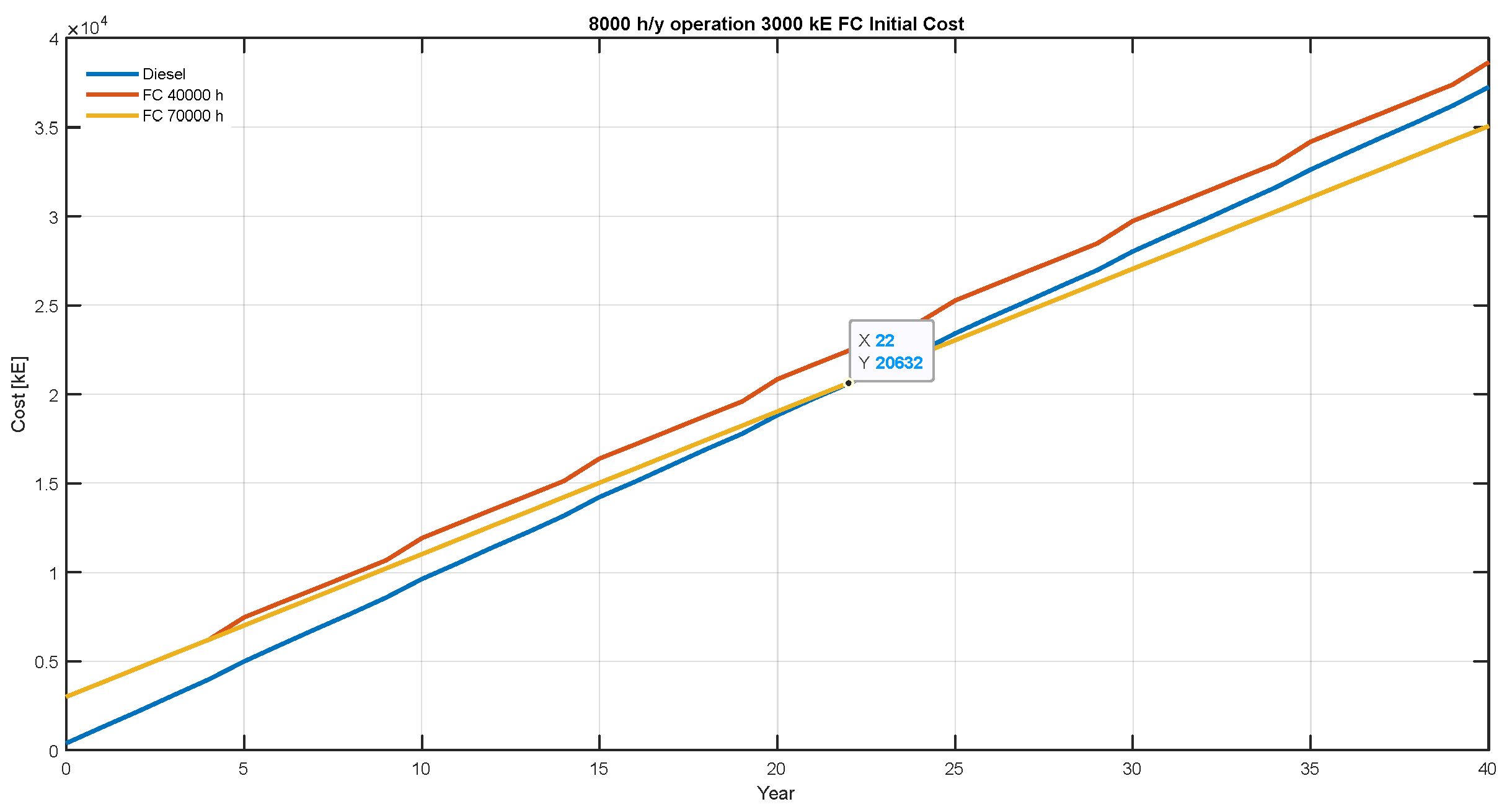
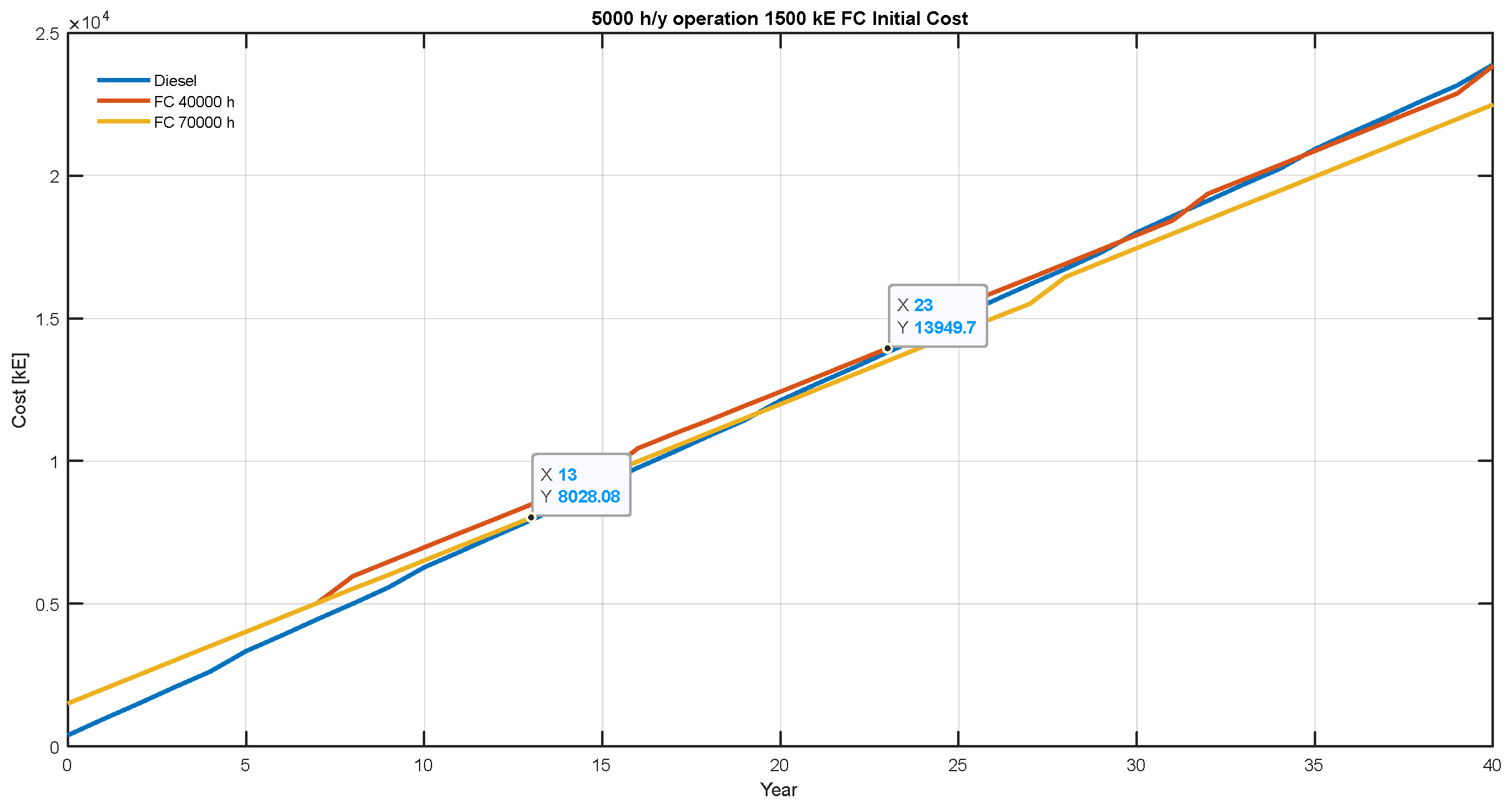
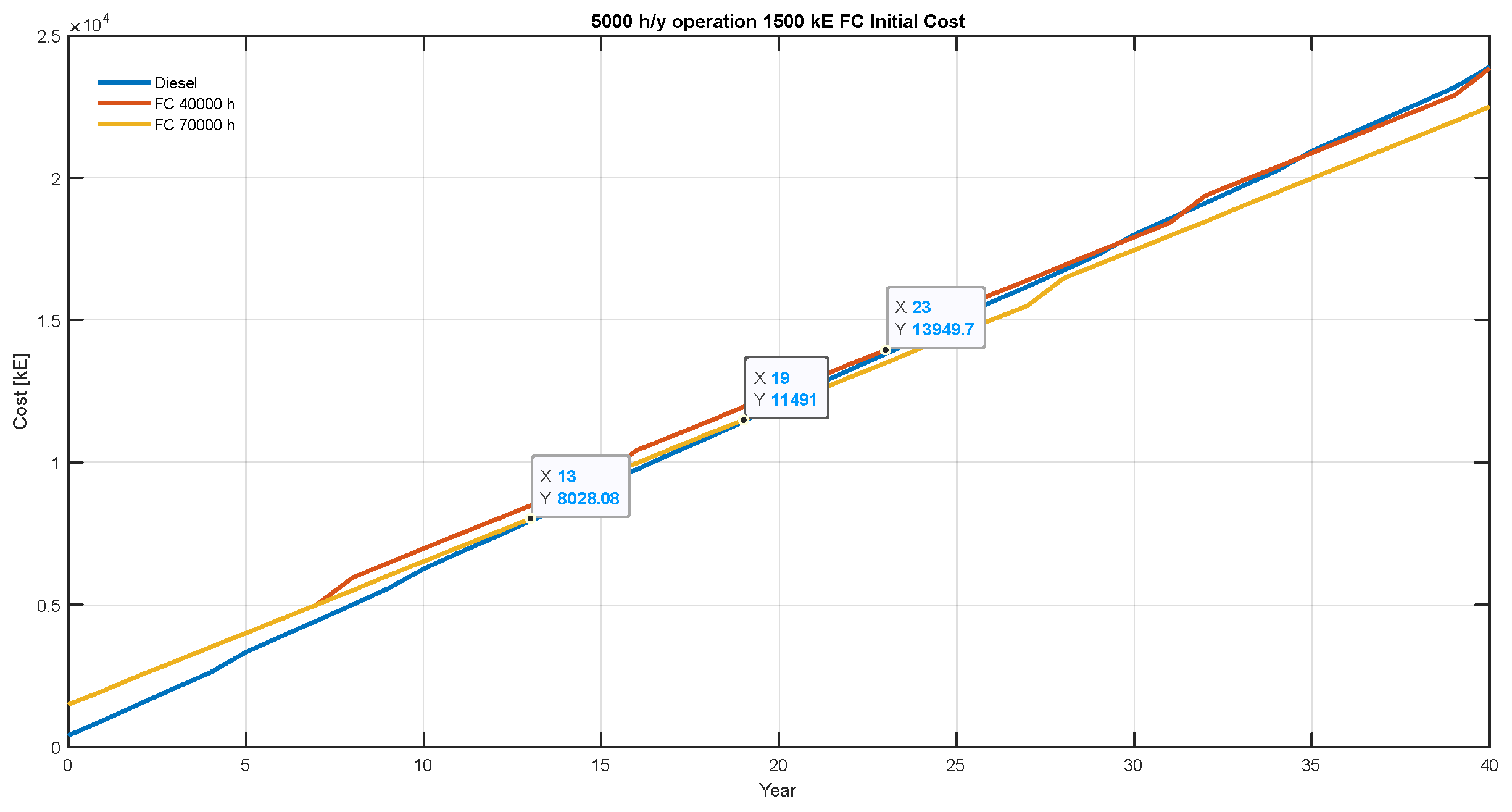


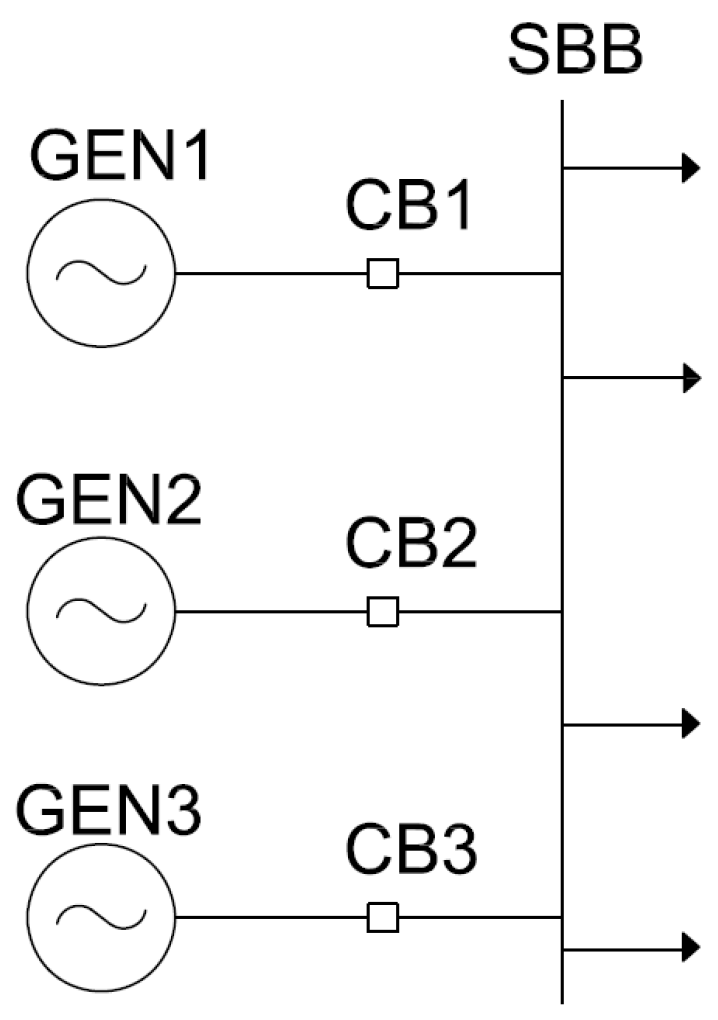



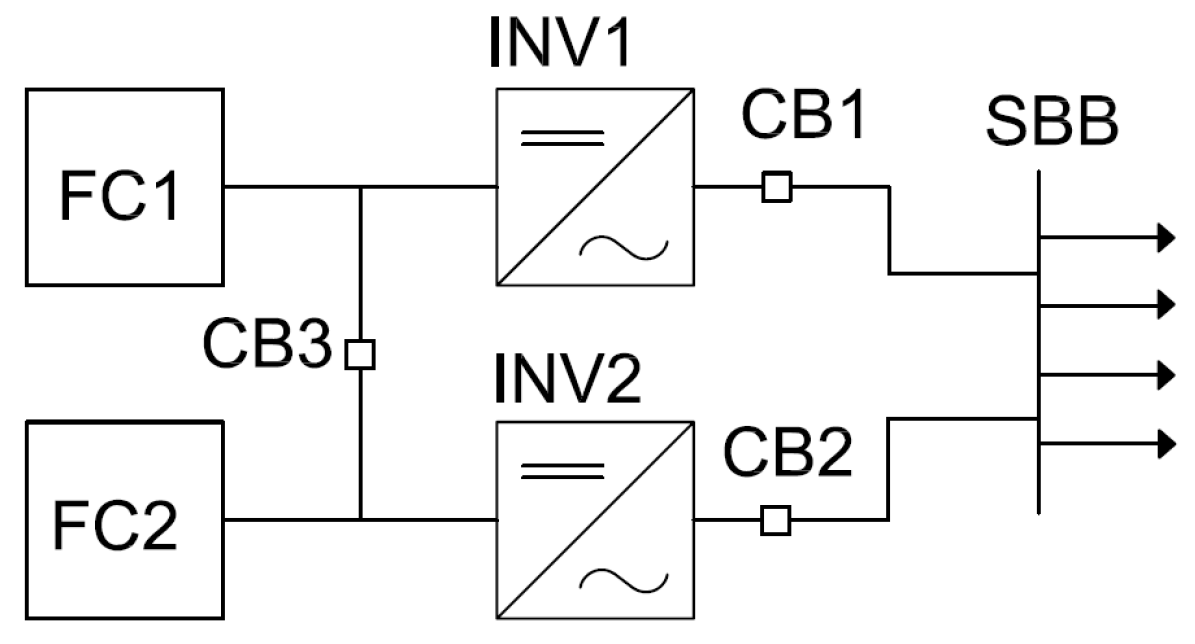



| Model | Engine | kVA Stand-By | Emission Standards | [L/H] | Length [mm] | Width [mm] | Height [mm] | Weight [kg] |
|---|---|---|---|---|---|---|---|---|
| C32 1100 | C32 | 1100 | Low Emissions | 243.2 | 4795 | 1695 | 2162 | 6668 |
| C32 1250 | C32 | 1250 | Low BSFC | 252.4 | 4874 | 1695 | 2162 | 6985 |
| C32 1400 | C32 | 1400 | Low BSFC | 292 | 4551 | 2231 | 2175 | 8099 |
| C32 1500 | C32 | 1500 | Low BSFC | 314 | 4551 | 2231 | 2175 | 8099 |
| 3512TA1400 | 3512 | 1400 | Low BSFC | 297.8 | 5248 | 1974 | 2367 | 9072 |
| 3512BTA 1500 | 3512 | 1500 | Low Emissions | 331.5 | 5237 | 1975 | 2342 | 12,594 |
| 3512BTA 1600 | 3512 | 1600 | Low Emissions | 323.5 | 5358 | 1975 | 2367 | 12,896 |
| 3512BHDTA 1750 | 3512 | 1750 | Low Emissions | 355.2 | 5469 | 2286 | 2367 | 12,642 |
| 3512BHDTA 1875 | 3512 | 1875 | Low Emissions | 395.5 | 5395 | 2286 | 2367 | 12,642 |
| 3516TA 2000 | 3516 | 2000 | Low BSFC | 420.9 | 6329 | 2286 | 2410 | 16,670 |
| 3516BTA 2250 | 3516 | 2250 | Low Emissions | 495.1 | 6373 | 2286 | 2494 | 155,535 |
| 3516BHDTA 2500 | 3516 | 2500 | Low Emissions | 542.7 | 6373 | 2286 | 2494 | 155,535 |
| 3516CHDTA 2750 | 3516 | 2750 | Low Emissions | 572 | 7542 | 2569 | 3096 | 19,750 |
| Tank | ||||
|---|---|---|---|---|
| Volume | Weight | Volume | Weight | |
| [m3] | [t] | [m3/h] | [kg/h] | |
| Generator | 24 | 12.5 | 0.33 | 129.23 |
| FC + Accessories | 33 | 22 | 0.28 | 120.54 |
| Fuel Cell | Traditional | ||
|---|---|---|---|
| Initial cost | [kEUR] | 1500/3000 | 400 |
| LNG price | [EUR/kg] | 0.8 | 0.8 |
| Hourly consumption of LNG | [L/h] | 287 | 331.5 |
| [kg/h] | 120.54 | 139.23 | |
| Hourly consumption | [EUR/h] | 96.432 | 111.384 |
| Annual hours | [h] | 5000–8000 | 5000–8000 |
| Maintenance | Fuel cell | Traditional | |
| Annual maintenance | [EUR/year] | 30,000 | \ |
| Maintenance 5 years | [EUR/5years] | \ | 150,000 |
| Maintenance every 40,000–70,000 h | [EUR] | 450,000 | \ |
| Initial Cost [kEUR] | Stack Replacement [h] | Maintenance [h/year] | Years [y] |
|---|---|---|---|
| 3000 | 40,000 | 5000 | >40 |
| 3000 | 70,000 | 5000 | >40 |
| 3000 | 40,000 | 8000 | >40 |
| 3000 | 70,000 | 8000 | 22 |
| 1500 | 40,000 | 5000 | 30 |
| 1500 | 70,000 | 5000 | 19 |
| 1500 | 40,000 | 8000 | 24 |
| 1500 | 70,000 | 8000 | 9 |
| Component | Symbol | MTBF [h] |
|---|---|---|
| Circuit breaker | CB | 229,991 |
| UPS system | UPS | 72,574 |
| Control unit | CU | 750,000 |
| Fire-related risk factor | FRF | 438,000 |
| Inverter | INV | 50,000 |
| Switchgear busbar | SBB | 923,068 |
| Stack of FCs | FC | 100,000 |
| Auxiliary | Generator | |
|---|---|---|
| Failures (per unit year) | 3.9 | 4.3 |
| MTBF [h] | 2233.5 | 1997 |
| MTTR [h] | 2.9 | 6.4 |
| Failed Component | CB1 | CB2 | CB3 | Energy Provided by |
|---|---|---|---|---|
| FC1 | OPEN | CLOSED | OPEN | 100% FC2 |
| FC2 | CLOSED | OPEN | OPEN | 100% FC1 |
| INV1 | OPEN | CLOSED | CLOSED | 50% FC1 + 50% FC2 (INV1 sized on 100% of the ship power) |
| INV2 | CLOSED | OPEN | CLOSED | 50% FC1 + 50% FC2 (INV2 sized on 100% of the ship power) |
| MTBF [h] | ||
|---|---|---|
| [h] | Years | |
| 1 Generator | 1997 | 0.22 |
| 2 Generators | 2702 | 0.3 |
| 3 Generators | 3521 | 0.4 |
| 1 FC | 26,515 | 3.02 |
| 2 FCs | 38,073.3 | 4.35 |
| 3 FCs | 43,529 | 4.97 |
Disclaimer/Publisher’s Note: The statements, opinions and data contained in all publications are solely those of the individual author(s) and contributor(s) and not of MDPI and/or the editor(s). MDPI and/or the editor(s) disclaim responsibility for any injury to people or property resulting from any ideas, methods, instructions or products referred to in the content. |
© 2025 by the authors. Licensee MDPI, Basel, Switzerland. This article is an open access article distributed under the terms and conditions of the Creative Commons Attribution (CC BY) license (https://creativecommons.org/licenses/by/4.0/).
Share and Cite
Ruvio, A.; Elia, S.; Pasquali, M.; Pibiri, R.; McPhail, S.; Fontanella, M. Innovative Power Generation System for Large Ships Based on Fuel Cells: A Technical–Economic Comparison with a Traditional System. Energies 2025, 18, 1456. https://doi.org/10.3390/en18061456
Ruvio A, Elia S, Pasquali M, Pibiri R, McPhail S, Fontanella M. Innovative Power Generation System for Large Ships Based on Fuel Cells: A Technical–Economic Comparison with a Traditional System. Energies. 2025; 18(6):1456. https://doi.org/10.3390/en18061456
Chicago/Turabian StyleRuvio, Alessandro, Stefano Elia, Manlio Pasquali, Roberto Pibiri, Stephen McPhail, and Matteo Fontanella. 2025. "Innovative Power Generation System for Large Ships Based on Fuel Cells: A Technical–Economic Comparison with a Traditional System" Energies 18, no. 6: 1456. https://doi.org/10.3390/en18061456
APA StyleRuvio, A., Elia, S., Pasquali, M., Pibiri, R., McPhail, S., & Fontanella, M. (2025). Innovative Power Generation System for Large Ships Based on Fuel Cells: A Technical–Economic Comparison with a Traditional System. Energies, 18(6), 1456. https://doi.org/10.3390/en18061456







